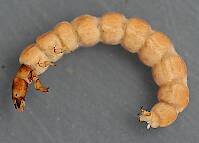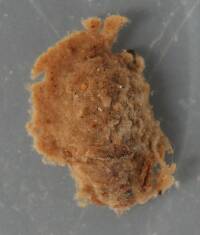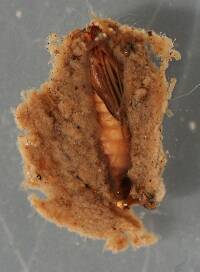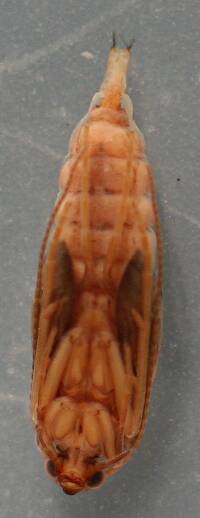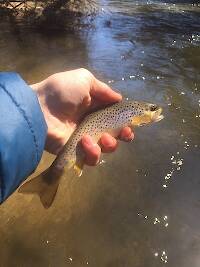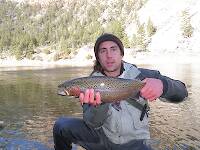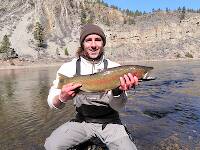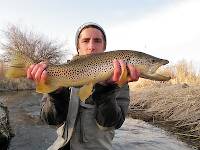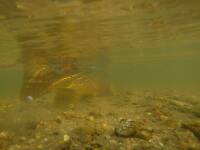
Blue-winged Olives
Baetis
Tiny Baetis mayflies are perhaps the most commonly encountered and imitated by anglers on all American trout streams due to their great abundance, widespread distribution, and trout-friendly emergence habits.
Featured on the forum

Some characteristics from the microscope images for the tentative species id: The postero-lateral projections are found only on segment 9, not segment 8. Based on the key in Jacobus et al. (2014), it appears to key to Neoleptophlebia adoptiva or Neoleptophlebia heteronea, same as this specimen with pretty different abdominal markings. However, distinguishing between those calls for comparing the lengths of the second and third segment of the labial palp, and this one (like the other one) only seems to have two segments. So I'm stuck on them both. It's likely that the fact that they're immature nymphs stymies identification in some important way.

Troutnut is a project started in 2003 by salmonid ecologist Jason "Troutnut" Neuswanger to help anglers and
fly tyers unabashedly embrace the entomological side of the sport. Learn more about Troutnut or
support the project for an enhanced experience here.
Troutnut on Oct 17, 2006October 17th, 2006, 6:33 am EDT
I just found a bizzarre Wikipedia entry on "trout tickling."
There are some odd things on that site...
There are some odd things on that site...
Jason Neuswanger, Ph.D.
Troutnut and salmonid ecologist
Troutnut and salmonid ecologist
GONZO on Oct 17, 2006October 17th, 2006, 10:09 am EDT
Perhaps fishermen in Shakespeare's time had skills we lack. But, exactly how one gets into position to "tickle" a wild trout totally escapes me!
I'm not completely skeptical, though, because my wife seems to have the knack. Often, when she releases a trout that I've caught, she tickles the fish's belly and chin. The trout will seem quite contented and remain in the spot until I tap its tail to get it to move on. I've had released fish sit calmly by my boots on occasion, but she seems to be able to do it every time.
I'm not completely skeptical, though, because my wife seems to have the knack. Often, when she releases a trout that I've caught, she tickles the fish's belly and chin. The trout will seem quite contented and remain in the spot until I tap its tail to get it to move on. I've had released fish sit calmly by my boots on occasion, but she seems to be able to do it every time.
Troutnut on Oct 17, 2006October 17th, 2006, 10:24 am EDT
Hm, now that you mention it, maybe this would be a good way to get neat underwater pictures of released fish.
I've got a few pictures on this site that I took that way, by releasing the trout very gently so they just sit by my feet for a while. Maybe tickling them a little would make it easier.
I've got a few pictures on this site that I took that way, by releasing the trout very gently so they just sit by my feet for a while. Maybe tickling them a little would make it easier.
Jason Neuswanger, Ph.D.
Troutnut and salmonid ecologist
Troutnut and salmonid ecologist
GONZO on Oct 17, 2006October 17th, 2006, 10:31 am EDT
I asked my wife if she had any tips to offer, but she says it's a "gift."
Shawnny3 on Oct 17, 2006October 17th, 2006, 11:57 am EDT
I have an uncle who's one of the best fisherman I've ever known, and he says that growing up he and his brother would often go to the stream without rods and catch large fish by hand in some of the big waters of Colorado. Tickling the fish was a big part of the strategy, apparently, which he describes as follows:
Wade carefully up to a large rock with a likely trout lie, then slowly dip your hands well below the rock and begin raising them in a slow tickling motion into the lie. When you feel a fish, tickle its belly for a few minutes to relax it and get it used to your presence, then slowly wrap one hand around its tail and pull it slowly from the water. If done right, the fish will barely struggle at all.
I'm not sure how legal taking fish this way is, but my uncle would always release his fish - they would do this just for fun.
My uncle is very serious, if not a bit intense, when it comes to fishing, and is definitely NOT the sort of person inclined to embellish stories (if anything, he tends to play down his amazing feats), so I have no reason to disbelieve any of this. I would love to try this sometime, but I have a bit of an irrational fear of wiggling my fingers under large rocks in the stream - however insane it is, I just can't seem to shake from my mind the image of a muskie relieving me of one of my fingers...
-Shawn
Wade carefully up to a large rock with a likely trout lie, then slowly dip your hands well below the rock and begin raising them in a slow tickling motion into the lie. When you feel a fish, tickle its belly for a few minutes to relax it and get it used to your presence, then slowly wrap one hand around its tail and pull it slowly from the water. If done right, the fish will barely struggle at all.
I'm not sure how legal taking fish this way is, but my uncle would always release his fish - they would do this just for fun.
My uncle is very serious, if not a bit intense, when it comes to fishing, and is definitely NOT the sort of person inclined to embellish stories (if anything, he tends to play down his amazing feats), so I have no reason to disbelieve any of this. I would love to try this sometime, but I have a bit of an irrational fear of wiggling my fingers under large rocks in the stream - however insane it is, I just can't seem to shake from my mind the image of a muskie relieving me of one of my fingers...
-Shawn
Jewelry-Quality Artistic Salmon Flies, by Shawn Davis
www.davisflydesigns.com
www.davisflydesigns.com
Troutnut on Oct 17, 2006October 17th, 2006, 2:47 pm EDT
I just can't seem to shake from my mind the image of a muskie relieving me of one of my fingers...
Or a large flathead catfish.
Poachers use a similar method in Missouri to catch catfish in the ugly, nasty warmwater rivers there. Once in a great while one of them would lose a body part or two.
Jason Neuswanger, Ph.D.
Troutnut and salmonid ecologist
Troutnut and salmonid ecologist
Ratgunner on Mar 24, 2007March 24th, 2007, 5:16 pm EDT
I've tickled trout a few times,but that was long ago I don't think I'm that stealthy anymore.
-Tim
Daviecoyle on Oct 1, 2009October 1st, 2009, 4:26 am EDT
Guddling for fish is dependently not a myth. My granddad tells me how he used to guddle fish up the nearest burn and how it was hard going in those days if you didn’t poach fish or pheasant and snare rabbit and hare then your family had every chance of starving.
Although he tells me it was hard going which I imagine it was, the thoughts still there that they used to dine on fresh salmon pheasant rabbit and brown trout. I couldn’t afford to do that now!
Mention the word guddling where I’m from in Scotland and there’s very few males that would not know what you meant.
I have tried as a very young boy to guddle brown trout in the same burn as my granddad but to no avail. I understand that is a tremendous skill to do it and it’s something that needed to be taught. It’s a shame that my grandfather can’t pass on this skill to me as I don’t see him kneeling down in freezing cold water at the age of 85.
However I will go and try again at some point to see if I can pick this skill up. Maybe it was just my boyhood ignorance that spoiled my chances of slinging a brown trout to the bank.
If anyone else decides they would like to try guddling here is what I know from my granddad.
Threes two methods the first you go to the spot that you see a trout has been spooked from and stand crouched near to the water or on your knees if possible. Once the fish comes back which it generally does due to an Eddie in the water, slowly lower your hands into the water a few feet apart. Bring your hands carefully together trying to work out where the underbelly of the fish is and touch the tail of the fish. Tickle with your forefingers gradually moving up the fish to where the gills are. if you can catch the gills with your finger and if not try and grasp and fling the fish to the shore. The other method is used if the fish darts under a sill or something at the bank of the water. You should then lie down on the bank and put your hands apart as wide as possible keeping where you think the fish is in line with your head. Gently feel along under the ledge or rock until you think you have found the fish. Again do the same tickling manoeuvre and then hook the fish through its gills pulling it out.
Although he tells me it was hard going which I imagine it was, the thoughts still there that they used to dine on fresh salmon pheasant rabbit and brown trout. I couldn’t afford to do that now!
Mention the word guddling where I’m from in Scotland and there’s very few males that would not know what you meant.
I have tried as a very young boy to guddle brown trout in the same burn as my granddad but to no avail. I understand that is a tremendous skill to do it and it’s something that needed to be taught. It’s a shame that my grandfather can’t pass on this skill to me as I don’t see him kneeling down in freezing cold water at the age of 85.
However I will go and try again at some point to see if I can pick this skill up. Maybe it was just my boyhood ignorance that spoiled my chances of slinging a brown trout to the bank.
If anyone else decides they would like to try guddling here is what I know from my granddad.
Threes two methods the first you go to the spot that you see a trout has been spooked from and stand crouched near to the water or on your knees if possible. Once the fish comes back which it generally does due to an Eddie in the water, slowly lower your hands into the water a few feet apart. Bring your hands carefully together trying to work out where the underbelly of the fish is and touch the tail of the fish. Tickle with your forefingers gradually moving up the fish to where the gills are. if you can catch the gills with your finger and if not try and grasp and fling the fish to the shore. The other method is used if the fish darts under a sill or something at the bank of the water. You should then lie down on the bank and put your hands apart as wide as possible keeping where you think the fish is in line with your head. Gently feel along under the ledge or rock until you think you have found the fish. Again do the same tickling manoeuvre and then hook the fish through its gills pulling it out.
______ ) ___
(, / ) , (__/_____) /)
/ / _ _ _ _ / ___ // _
_/___ /_(_(_(/___(__(/_ / (_) (_/_(/__(/_
(_/___ / (_____
(, / ) , (__/_____) /)
/ / _ _ _ _ / ___ // _
_/___ /_(_(_(/___(__(/_ / (_) (_/_(/__(/_
(_/___ / (_____
Quick Reply
Related Discussions
Topic
Replies
Last Reply
2
Jan 23, 2017
by Mcflyangler
by Mcflyangler
5
Dec 24, 2007
by Martinlf
by Martinlf
12
Apr 15, 2015
by MiltRPowell
by MiltRPowell



